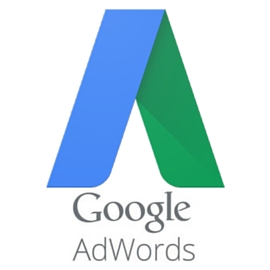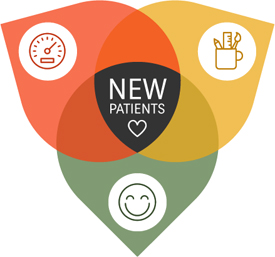 You might be thinking, “I know I need to advertise my practice online, but I don’t know how.”
You might be thinking, “I know I need to advertise my practice online, but I don’t know how.”
Or, you’re thinking, “I’m currently a paying a boatload of money on online advertising campaigns that are not producing new patients.”
Either way, you’re missing out on a big opportunity. Long gone are the days when yellow page ads provided a good return on investment. Instead of shuffling through a big yellow book, prospective patients have turned to the Internet to find a new dentist.
So where do you begin? It’s not something to jump right into. It’s important to get all your ducks in row before launching your first digital ad campaign.
![]()
Instant Exposure in Google
Most online advertising platforms follow a pay-per-click (PPC) model. In short, PPC means you pay each time someone clicks on one of your ads. Google offers the largest PPC platform in its AdWords service.
No need to wait for the long-term benefits of search engine optimization. AdWords gives you instant exposure by allowing you to “outrank” your competitors at the top of the page.
There are countless factors that go into building a successful PPC campaign. Choosing relevant keywords, setting the right budget, writing compelling ad copy, etc. But one of the most overlooked variables in the PPC industry is the harmony between your ads and your website.
Syncing Ads With Your Website
A common misconception is that you can set up your ads, apply the right keywords, and you’re good to go. This, however, is the downfall of most PPC campaigns. Your ads and the pages your ads link to must be in sync.
Say that you’re running a Google Ads campaign for Invisalign:
- You set up an AdWords account
- Set a budget
- Bid on keywords related to orthodontic care
- Write your ad copy
- Link your ad to your contact page
While that final step (linking to a landing page) is required to activate a campaign, it is often added without much thought. Most PPC providers are even guilty of it. Why? Because most providers don’t have access to a client’s website; therefore, they don’t bother customizing a landing page for a specific ad.
The problem is, your PPC ads and landing pages work together to produce new patients.
Say that your practice is located in Baltimore, Maryland and your ad promotes Invisalign. Your landing page should be relevant to the ad and you should use similar verbiage and keywords.
Doing so will increase the relevancy of your ad and ensure that only patient-ready users click on it.
Note: One of the biggest PPC mistakes is to direct prospects to your home page. Your ad should direct people to a unique page specifically customized for your ad.
Patient-Converting Dental Website Design
 You can waste a lot of money by bidding on the wrong keywords. You can waste even more money if your dental website design doesn’t convert new patients. Remember, the look and feel of your website is the foundation of your online presence.
You can waste a lot of money by bidding on the wrong keywords. You can waste even more money if your dental website design doesn’t convert new patients. Remember, the look and feel of your website is the foundation of your online presence.
And without a strong foundation, your PPC campaigns will fail.
You can post on social media, secure high search engine rankings, and run one PPC campaign after another. But if you don’t engage visitors once they land on your site, your efforts are futile.
Look at it this way: You’re PPC campaigns are designed to attract visitors to your site; your website design converts those visitors into patients. To get new patients from the Internet (which, after all, is your number-one goal), both elements must be optimized.
Here are some of the key components of a patient-converting dental website design:
- Mobile-friendliness: In addition to being included in Google’s ranking algorithm, mobile-friendliness maintains a good user experience on all types of devices. If your design is not mobile-friendly, Google will not show your ad on mobile devices. This means you could miss out on about half, if not more, of the potential traffic.
- The “Money pages”: Simply having a homepage and contact page isn’t going to cut it. There are five pages, what we call the “Money Pages,” that comprise a patient-converting design. In order of importance, they are: Homepage, doctor[s] bio, contact us, about us, and services.
- Persuasive copy: Your website should do much more than just outline what you have to offer. It should tell visitors why they should choose you as their dentist. This means crafting copy that tells your story in a compelling way. These days, this requires the expertise of professional writers.
- Engaging photos: As the old adage goes, “A picture is worth a 1,000 words.” To make your practice stand out, you should include at least one image on each page. Note that 61 percent of consumers say they feel better about a company that features custom photography.
- Browsability: People don’t have the patience to scan through pages containing large paragraphs of text. Spreading out your content with headings and bullets keeps visitors reading.
- Frequent updates: It used to be the case that once you designed your website, your job was finished. Today, a high-performing website requires constant attention. Keep your website updated by posting blogs, revising old content, and redesigning your website every few years.
- Special offer: Posing a special offer with your ad offers two benefits: 1) Increases the number of clicks your ad receives; 2) Boosts the percentage of people who “convert” after landing on your website.
Who Will Run Your Dental PPC Campaigns?
 Poorly-run PPC campaigns can be costly. So if you don’t have experience with online advertising, you’ll have to choose one of two options: 1) Become an expert in the PPC field; or 2) Outsource your campaigns to a PPC provider.
Poorly-run PPC campaigns can be costly. So if you don’t have experience with online advertising, you’ll have to choose one of two options: 1) Become an expert in the PPC field; or 2) Outsource your campaigns to a PPC provider.
If you choose the latter option, be sure that the provider has access to your website. To run an efficient, patient-producing PPC campaign, your provider must create custom pages on your site that sync with your PPC campaigns.
That’s why, ideally, you choose an integrated dental website service that manages all your online marketing campaigns.
Partnering with a company that is willing to take responsibility for your overall online marketing strategy eliminates the need for you to manage a group of freelancers. Not only is it time-consuming, managing multiple vendors often leads to finger pointing when the question of failure arises.
![]()
Want to learn how Google AdWords can expand your new patient reach? Learn how an integrated PPC strategy is the ideal new patient solution.


